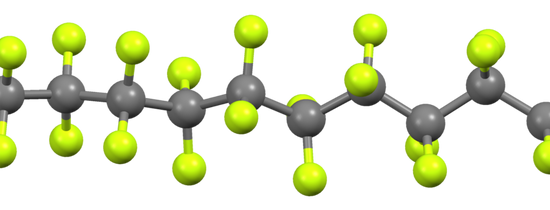What is PTFE?
The commonly known brand name of composition is Teflon by Chemours, a spin-off from DuPont, which originally discovered the compound in 1938.
Polytetrafluoroethylene or shortened as “PTFE” is a synthetic fluoropolymer of tetrafluoroethylene and is a PFAS that has numerous applications.
PTFE is a fluorocarbon solid, as it is a high-molecular-weight polymer consisting wholly of carbon and fluorine. PTFE is hydrophobic: neither water nor water-containing substances wet PTFE, as fluorocarbons exhibit only small London dispersion forces due to the low electric polarizability of fluorine. PTFE has one of the lowest coefficients of friction of any solid.
How PTFE functions?
PTFE is often used as a nonstick coating for pans and other cookware. It is non-reactive, partly because of the strength of carbon–fluorine bonds. This unique polymer coating prevents food from sticking in the pans during the cooking process. It brings easy cleaning and significantly smooth nonstick performance.
Is PTFE safe to use?
Most people are generally concerned that it is a toxic substance that can cause health problems, including cancer. Like other chemicals used in different fields, it may be considered a hazardous material by the majority of people. But that doesn’t mean you need to stay away from pans that are coated with PTFE.
Many studies have shown that PTFE itself is not considered a carcinogen and is one of the most chemically inert, non-toxic and non-flammable substances when tested under normal conditions of use.
However, two of the most well-known and well-studied PFAS are perfluorooctanoic acid (PFOA) and perfluorooctane sulfonic acid (PFOS) which were used to make PTFE. However, production and importation of these 2 chemicals were phased out in the mid-2000s because of their environmental and health impacts, according to the U.S. Environmental Protection Agency (EPA).
While our products are PFOA and PFOS free, that’s the least of your worries.
Other things you should know about PTFE
Although it's not harmful to health, overheating a nonstick pan can still cause a variety of problems. When the pan gets too hot, the compounds in the coating release toxic fumes. Overheating the pan can also reduce the effectiveness of nonstick cookware coatings. PTFE begins to decompose at about 250°C, or about 480°F, releasing toxic fumes into the air.
Therefore, taking good care of your nonstick cookware can help to extend its lifespan for the long run.
Here are some suggestions when using cookware for daily uses:
1. Avoid using metal utensils.
Start to say “No” to metal utensils as these will scrape your beautiful pan with irreversible scratches that will shorten its longevity, soft utensils are all you need with nonstick pan, such as wooden or silicone material.
2. Never leave the pan unattended
Remember to apply a small amount of oil before heating up the pan. Empty heating the pan will gradually deteriorate nonstick property, often by creating discolored surface with brown or even dark color
3. Try to hand wash cookware.
Dishwasher brings a whole lot advantages but the high temperature and harsh detergent would slowly erode the coating and reduce its nonstick ability. Washing with warm soapy water or neutral detergent with soft sponges or pads will be a smart move.


